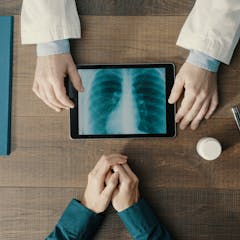
Articles on Diagnosis
Displaying 1 - 20 of 128 articles

Having asymptomatic flat feet is not a problem and does not require treatment. It’s important to debunk this common myth.

Having both conditions at the same time increases your risk of dying prematurely. But it can be treated. Here’s what’s involved.

Future AI large language models like Google’s AMIE might prove to fill gaps in health-care delivery, however, they must be adopted with caution.

Some people with microscopic colitis avoid going outdoors.

Endometriosis often means years of severe pain, lost productivity and dismissed symptoms before getting a diagnosis — followed by ineffective treatment. New funding aims to change this pattern.

Before AI becomes widespread in health care, we need to ask what matters to consumers.

People with intellectual disability are 50% more likely to die from cancer than the general population.

More often than not, it is women who have been gaslighted by medical professionals.

Since the time of Hippocrates, doctors have looked at patients hands for signs of ill health.

People who developed diabetes, psychosis and congestive heart failure, in that order, experienced the largest reduction in life expectancy

A chatbot that lets users express their feelings by drawing may help communication and treatment for people with chronic pain.

Increasing awareness of migraine symptoms is critical for those living with undiagnosed migraine, since getting a diagnosis is the first step to receiving appropriate and effective care.

Our new study demonstrates the enormous potential that machine learning has to help identify people with AS

Diagnosis is more than the medical process of identifying an illness. It’s a social agreement about what counts as disease and a storytelling tool to make sense of dysfunction.

People can be reluctant to discuss symptoms with their doctor. When they do, their symptoms can be mistaken for other illnesses. Even when people are diagnosed, they don’t always get the right treatment.

The pandemic spurred the diagnostics industry to consider aspects like scale, affordability, speed and portability of tests.

Research shows most people who can’t even recognise their family and friends won’t get the diagnosis needed to help them.

After an outcry on social media over its requirement that writers provide a medical diagnosis, Black Inc. has put on hold a planned anthology: Growing up Neurodivergent in Australia.

A panel of experts has deemed the digital rectal examination to be inferior to MRI in monitoring prostate cancer in men.

Doctors don’t always tell you they’re unsure what’s behind common symptoms, such as a stomach ache. And that can have serious effects.





